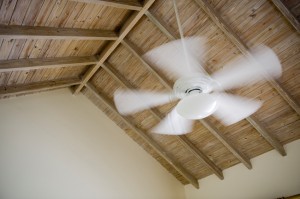Tools Needed to Hang a Ceiling Fan
New ceiling fans come with instructions explaining how to install them yourself. Doing so requires standard tools you probably already have around the house. Reading the instructions ahead of time allows you to mentally walk through the installation process ahead of time, comparing illustrations in the manual to their respective parts on the fan and preparing tools for the job. A friend is also a great asset during the installation process, as a fan can be quite heavy and difficult to hold up as you secure it to the ceiling.
Screwdrivers or Driver Bits
One of the most important tools is also the most basic: a screwdriver. If the fan arrived unassembled, a screwdriver may be needed to attach the blades to the blade housing on the motor assembly. It’s also used to attach the fan’s ceiling plate to the support mechanism in place on the ceiling. A fan’s weight requires more support than a standard light fixture, so if adding a support or junction box rated for ceiling fans, you’ll need a screwdriver
Drill
A power drill is used to drill pilot holes and driving screws to mount a new ceiling junction box to ceiling joists or for installing and mounting to blocking between the joists. Fitted with a screwdriver bit, a drill allows for speedy attachment of the fan motor hardware to the ceiling, reducing the amount of time and strain that would be experienced if using a standard manual screwdriver. A cordless power drill offers freedom from a cord getting in your way during fan installation
Wrench
The down-rod pipe, a pipe that protects and houses electrical wires coming out of the fan, requires a wrench to tighten the locking screw which holds the pipe in place within the fan assembly. An adjustable wrench tightens this, as well as smaller nuts that may be part of your fan assembly; specific sizes, screws and nuts vary by manufacturer
Electrical Tools and Supplies
Wire strippers allow you to both trim wires to size and strip the plastic coating off wire ends, exposing them to create electrical connections. Wire strippers may be needed on both existing wires within the ceiling, as well as the wires protruding from the fan motor assembly. Electrical tape and wire connectors secure fan wires to house wiring. An electrical tester allows you to test wires within the ceiling after shutting off power to the area, ensuring that power really is off before doing the electrical portion of this project.

How to Install a Ceiling Fan With a Handheld or Wall Remote
Many new ceiling fans come equipped with remote control, especially higher-priced ceiling fans. The receiver part of the remote is nestled inside the fan body itself, while the control mounts either on the wall or into the wall as a switch. If you’ve been thinking about replacing your existing ceiling fans, it is relatively easy to do this project yourself. If you can change an electrical receptacle, you can install a ceiling fan. Here are more details for this DIY home improvement project.
Before You Buy a Ceiling Fan
Ceiling fans can improve home energy efficiency and provide a decorative upgrade. However, don’t run out to buy the first cute ceiling fan you see.
Ceiling Height
Ceiling heights below 9 feet might require a fan that hugs the ceiling, known as a flush mount. Find out the distance between the ceiling and the bottom of the fan, referred to as the hanging depth. Allow at least 7 feet from the bottom of the fan to the floor to avoid getting hit when walking under spinning blades.
Blade Sweep
Experts say the number of blades isn’t as important as the size of the motor and the length of the blades. Larger motors cost more than smaller motors. Blades that measure 52 inches work better in rooms that are greater than 15 feet in length, whereas 44-inch blades are made for smaller rooms. If you are replacing a smaller fan with a larger fan, make sure the blades will not hit another object in the room, such as a door. Allow a minimum of 18 inches from the tip of the blade to the wall
Lighting Options
If you choose a light fixture requiring a fluorescent lamp, it is unlikely to be compatible with a dimmer switch, and you may need to replace your light switch beforehand. Consider whether you want the light to flood the room or to illuminate the ceiling.
Can I Install Ceiling Fans In Every Room?
Ceiling fans can improve your comfort during hot or cool weather by lowering the perceived temperature and helping your HVAC system to circulate heated or cooled air more efficiently. If your home doesn’t currently have ceiling fans installed, this is a simple electrical upgrade that your electrician
Ceiling Fan Installation
Ceiling fans can be installed in any room in your home, such as living rooms, dining areas, offices, and bedrooms. These fixtures make a great addition to rooms in which you spend a significant amount of time, as they can augment your home’s heating and cooling system all year round for improved comfort and energy savings. Ceiling fans can even be installed in outdoor living spaces, such as covered patios, porches, and pergolas. Ceiling fan installation is a task that should always be handled by a professional electrician, as it requires changes to the electrical wiring and, in some cases, the addition of a wall switch or breaker circuit. If your home’s electrical system is outdated, you may want to consider a panel box upgrade at the same time to handle the increased electrical usage. Your residential electrician will let you know the process involved in ceiling fan installation for your home, based on the number of fans you wish to install and where you would like them placed.
Ceiling Fan Considerations
If you do choose to install ceiling fans in one or more rooms in your home, there are a few considerations you should take into account. First, you’ll need to choose a ceiling fan with the appropriate size for the room in which it will be placed. The diameter of a fan affects its air circulation capacity, so you’ll need a larger fan to achieve the comfort levels you want in a larger room. Additionally, you’ll want to consider the aesthetics of the fan—it’s best to choose a ceiling fan that meshes with your home’s style and décor to create a seamless transition between your home and your new fixture. Finally, consider whether you want a ceiling fan with additional features, such as a light fixture, wireless control, or a high-efficiency electrical motor.
Frequently Asked Questions about Ceiling Fans
There are a few types of wired controls with no receivers. The most common are Single/Dual Slide Controls, or Rotary Knob Controls.
A Single Slide control will control ONLY the fan speeds, and requires a two-wire setup (One Hot – Positive, and One Negative/Neutral). The same as an on / off switch.
A Dual Slide control will control the fan speeds and light, and requires a three-wire setup (Two Hot – Positives, and One Negative/Neutral).
Most Wall Controls with Receivers are wired. Wired wall controls require a two-wire setup and speak with the Receiver via Dip Switches. Dip Switches are tiny little switches (typically 4-8 switches with on/off abilities) within the Wall Control and often on the Receiver (unless the Receiver is a Learn-Receiver, where the Wall Control must be programmed or ‘burned’ into the receiver to speak with each other). The Dip Switches on the Receiver and the Wall Control must match each other in order for the fan to function. Wireless wall controls work in the exact same fashion, but require a tiny battery to operate. (Typically a 12 Volt A23 Battery, commonly found in local stores / hardware stores.)
Most Remote Controls with Receivers speak via Dip Switches. Dip Switches are tiny little switches (typically 4-8 switches with on/off abilities) within the Remote Control and often on the Receiver (unless the Receiver is a Learn-Receiver, where the Remote Control must be programmed or ‘burned’ into the receiver to speak with each other). The Dip Switches on the Receiver and the Remote Control must match each other in order for the fan to function. Most remotes require a tiny battery to operate. (Typically a 12 Volt A23 Battery, 9 Volt Battery, or Two / Four AAA Batteries. Commonly found in local stores / hardware stores.)
Most controls that speak to receivers function via Dip Switches (explained previously). Though, on the other hand, some Receivers are learn-receivers and require a specific command from the Remote / Wall Control to function. Every manufacturer has a different set of commands required for the receiver to listen.
Controls in conjuction with CFL Bulbs.
Most controls come with a dimming function capability. While most light fixtures are transitioning or come with CFL (Compact Fluorescent Bulbs) these however do not having the dimming function capability and in conjunction with the controls that do may not work properly or have a slight hum noise, to the extent of burning out the receiver / computer board

Things to Consider When Buying a Wall Mounted Fan
If floor space is an issue, you may find that a wall mounted fan works best for your situation. Wall mounted fans are increasingly becoming more popular, as they are frequently found in homes, home gyms, garages, greenhouses, and outdoor patios.
While not all wall mounted fans are created equal, the assortment of brands on the market allows you to make the best decision and select a fan brand that is suitable to the environment where it will be used.
How Do Wall Mount Fans Differ from Ceiling Fans?
Ceiling and wall mounted fans both provide plentiful circulated ambient air throughout any environment, keeping you comfortable in summer and winter. While both provide adequate air flow, they vary in their operation.
Ceiling Fans
Ceiling fans provide comfort in the summer, as the fan circulates air throughout the living space. During the winter, ceiling fans can pull and circulate warm air trapped at the ceiling by setting them to circulate in the clockwise position. This will help to redistribute warm air throughout the living space.
Wall Mount Fans
Wall mounted fans tend to work in a different fashion. While fans circulate air, the wall mounted fans push air horizontally throughout the space and not down like ceiling fans. Depending on size and placement, the air circulated may not always be felt at a distance, and they cannot circulate warm air trapped at the ceiling.